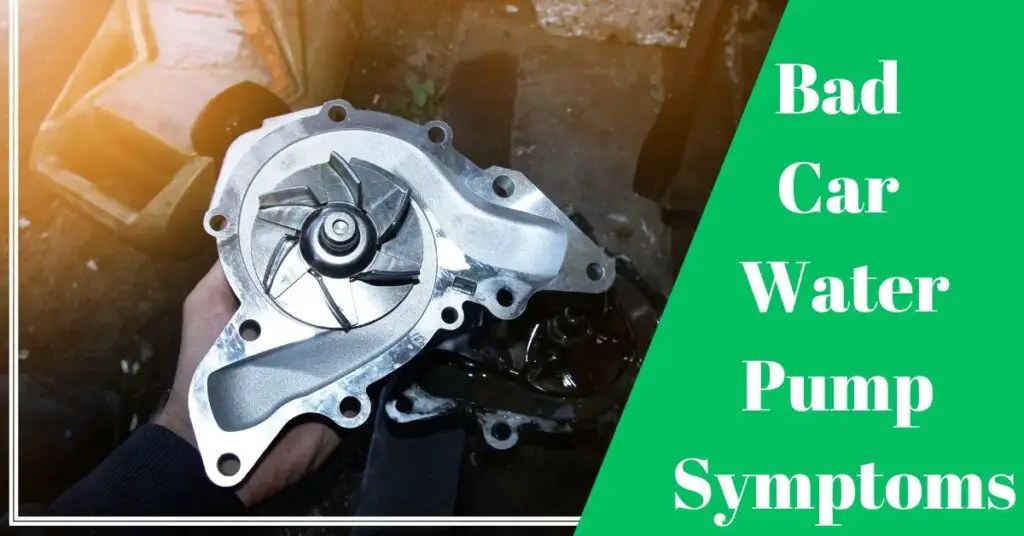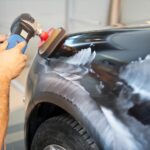The heart of a car’s cooling system, the water pump, plays a pivotal role in maintaining optimal engine performance. Just like a human heart circulates blood, the water pump keeps the coolant flowing, ensuring the engine stays at the right temperature. However, when this essential component malfunctions or bad car water pump symptoms appeared, it can spell disaster for the engine, leading to costly repairs or even engine replacement.
In the world of car maintenance, few components are as crucial to your engine’s health as the water pump. Responsible for regulating the engine’s temperature, a faulty water pump can lead to disastrous consequences if left unattended. Identifying early warning signs and taking proactive measures can save you from expensive repairs down the road.
In this blog, we’ll delve into the symptoms of a bad water pump, the potential causes behind its failure, and steps to diagnose and replace it.
Stay informed and protect your engine from overheating with our essential guide to car water pump issues.
Table of Contents
What is a Car Water Pump?
A car water pump is a vital component of a vehicle’s cooling system, designed to keep the engine running at its ideal temperature. Its primary function is to circulate coolant throughout the engine and the radiator, ensuring efficient heat transfer and preventing the engine from overheating.
Role in maintaining the engine’s optimal operating temperature
The water pump constantly pumps coolant from the radiator to the engine and back, absorbing excess heat generated during combustion. By regulating the engine’s temperature, the water pump enables it to operate within the optimal temperature range, maximizing fuel efficiency and engine performance.
Illustration of the water pump’s position in the cooling system
Typically driven by a pulley connected to the engine’s crankshaft or timing belt, the water pump is positioned near the front of the engine. It is directly linked to the cooling fan, which assists in dissipating heat from the radiator.
This strategic location allows the water pump to efficiently distribute coolant throughout the engine, keeping it cool even under heavy load or high temperatures.
Common Causes of Water Pump Failure
Age and wear as contributing factors
Over time, the mechanical components of the water pump undergo wear and tear, especially in older vehicles. The constant rotation of the pump’s impeller and exposure to high temperatures can lead to the deterioration of bearings, seals, and other critical parts. As the water pump ages, its efficiency decreases, making it more prone to failure.
Corrosion and cavitation leading to pump deterioration
Corrosion, caused by the chemical reaction between the coolant and the metal parts of the water pump, can weaken the pump’s structure and compromise its integrity. Additionally, cavitation, a phenomenon in which small bubbles form in the coolant due to pressure changes, can erode the pump’s impeller over time, reducing its pumping efficiency.
Contaminated coolant and debris clogging the pump
Impurities, sludge, and debris present in the coolant can accumulate within the water pump. This buildup can obstruct the flow of coolant, causing the pump to work harder and leading to premature failure. Using improper or low-quality coolant can exacerbate this issue, as it may not have the necessary additives to prevent corrosion and sludge formation.
Regular maintenance and timely coolant flushes can help mitigate these causes of water pump failure, ensuring the longevity and proper functioning of this critical component in the car’s cooling system.
5 Common Bad Car Water Pump Symptoms
A failing water pump can wreak havoc on your car’s cooling system, potentially leading to severe engine damage if not addressed promptly. Being vigilant about the following warning signs can help you catch a bad water pump early on and avoid costly repairs:
1. Overheating engine and high-temperature readings
If your engine temperature gauge consistently shows higher than normal readings or if the engine overheats, it could be a sign of a malfunctioning water pump. When the pump fails to circulate coolant effectively, the engine can’t dissipate heat properly, causing it to overheat.
2. Coolant leaks and puddles beneath the car
A leaking water pump can lead to coolant puddles forming beneath your parked car. Coolant is usually bright green, orange, or pink in color, making it easy to identify. Prolonged coolant leakage can lead to a low coolant level, exacerbating the risk of overheating.
3. Unusual noises from the water pump area
A faulty water pump may emit unusual noises, such as grinding, squeaking, or whining sounds. These noises are typically associated with a worn-out bearing or impeller, indicating that the water pump is struggling to function correctly.
4. Steam emanating from the engine compartment
Steam rising from the engine compartment can indicate an overheated engine. If you notice steam or a sweet-smelling aroma coming from under the hood, it could be a sign of coolant leaking onto hot engine components.
5. Wobbling water pump pulley and serpentine belt issues
A water pump with a loose or damaged pulley may wobble or exhibit abnormal movement. A wobbling pulley can throw off the alignment of the serpentine belt, leading to issues with other engine accessories and causing squealing noises.
Should you notice any of these symptoms, it’s essential to address the water pump issue promptly. Ignoring the problem could result in significant engine damage and leave you stranded on the side of the road.
Seeking professional inspection and repairs can save you from more extensive and costly repairs down the line.
Running Diagnostics on the Water Pump
Detecting water pump issues early on can prevent catastrophic engine damage and save you from costly repairs.
Using a pressure tester to identify leaks
To check for leaks in the cooling system, you can use a pressure tester. The tester is attached to the radiator or coolant reservoir, and it pressurizes the system.
If there are any leaks, you’ll likely see a drop in pressure, indicating the location of the leak. This can help pinpoint whether the water pump is the source of the problem.
Inspecting the pump for physical damage and corrosion
Visually examine the water pump for any signs of physical damage, such as cracks or leaks. Additionally, check for corrosion on the pump’s housing and fittings.
Corrosion can weaken the pump’s structure and lead to coolant leaks. If you notice any damage or corrosion, it’s essential to address it promptly.
Checking for loose or damaged belts and pulleys
The water pump is driven by a belt, usually the serpentine belt. Check for any signs of wear or damage on the belt, such as cracks or fraying.
A loose or damaged belt can affect the water pump’s performance, leading to issues with coolant circulation. Also, inspect the water pump pulley for any wobbling or misalignment, as this can indicate a problem with the pump’s bearing or shaft.
Regularly running these diagnostics can help you catch water pump issues before they escalate, allowing for timely repairs or replacement.
Replacing a Faulty Water Pump
If you’ve diagnosed a bad water pump and are ready to tackle the replacement yourself, follow this step-by-step guide:
Gathering necessary tools and safety precautions
Before starting, ensure you have the required tools, including a socket set, pliers, screwdrivers, and a new water pump gasket. Also, remember to take safety precautions, such as wearing protective gloves and eyewear, and working on a cooled-down engine.
Draining the cooling system
Begin by draining the coolant from the radiator. Place a drain pan under the radiator drain plug, open it, and let the coolant flow out. Remember to dispose of the old coolant properly, as it is toxic to the environment.
Removing the serpentine belt and pulleys
Loosen the tensioner pulley to relieve tension on the serpentine belt. Slip the belt off the water pump pulley and remove it from other engine accessories. Next, take off any pulleys obstructing access to the water pump.
Detaching the old water pump and cleaning the area
Disconnect the hoses and any remaining connections from the water pump. Then, remove the bolts securing the pump to the engine block. Gently pry the old water pump away, being cautious not to damage surrounding components. Thoroughly clean the mounting surface to ensure a proper seal for the new water pump.
Installing the new water pump and reassembling
Position the new water pump in place and secure it with the bolts. Refer to the vehicle’s repair manual for the specific torque settings. Reconnect the hoses and other components you removed earlier. Put back any pulleys you detached, ensuring they are correctly aligned.
Refilling the cooling system and testing for leaks
Refill the cooling system with the appropriate mixture of coolant and water. Be sure to follow the manufacturer’s recommendations for the correct coolant type and mixture.
Once filled, start the engine and allow it to reach operating temperature. Keep a close eye on the water pump area for any signs of leaks.
Completing a water pump replacement requires a reasonable level of mechanical skill and knowledge. If you are unsure about any step or encounter difficulties during the process, it is recommended to seek assistance from a qualified mechanic to ensure a successful replacement and avoid potential issues with the cooling system.
You can find a water pump replacement for your car HERE.
Preventive Maintenance for the Water Pump
A proactive approach to maintaining your car’s water pump can extend its lifespan and prevent costly repairs.
Regular coolant system inspections and flushes
Schedule periodic coolant system inspections as part of your routine maintenance. A professional mechanic can check for signs of coolant leaks, inspect the water pump for wear and damage, and assess the overall condition of the cooling system.
Additionally, regular coolant flushes help remove accumulated debris and contaminants, preventing clogs and corrosion that can affect the water pump’s efficiency.
Replacing the timing belt and water pump together
In many vehicles, the water pump is driven by the timing belt. If your car’s timing belt needs replacement, it is wise to replace the water pump at the same time, even if it shows no visible signs of damage.
Since both components share a similar lifespan and the timing belt replacement involves accessing the water pump, it saves time and money to address both at once.
Using high-quality coolant and distilled water
Always use the manufacturer-recommended coolant to ensure compatibility with your car’s cooling system. High-quality coolants contain additives that protect against corrosion and cavitation, enhancing the longevity of the water pump and other cooling system components.
Also, when topping up or mixing coolant, use distilled water to prevent mineral buildup and deposits that could impede the water pump’s performance.
Following these preventive maintenance measures, you can prolong the life of your water pump, minimize the risk of overheating, and maintain a reliable and efficient cooling system for your vehicle.
Remember to consult your car’s service manual or a qualified mechanic for specific maintenance intervals and recommendations based on your vehicle’s make and model.
Seeking Professional Help
While some car repairs can be done by DIY enthusiasts, dealing with the water pump is a critical task that often requires the expertise of a professional mechanic.
Knowing when to consult a mechanic
If you’re uncertain about diagnosing or fixing water pump issues, it’s best to consult a mechanic. Warning signs like overheating, coolant leaks, or unusual noises should not be ignored.
A mechanic can accurately identify the problem, prevent further damage, and advise on the necessary repairs.
The benefits of professional water pump replacement
Professional mechanics have the experience, training, and tools to perform water pump replacement efficiently and accurately. They can ensure proper installation, alignment, and sealing, reducing the risk of leaks and subsequent engine damage.
Additionally, they have access to high-quality replacement parts, giving you peace of mind knowing that your car’s cooling system will function optimally.
Cost considerations and warranties
While DIY repairs may seem cost-effective initially, improper installation or diagnosis can lead to more expensive repairs in the long run.
Professional mechanics offer warranties on their services and parts, providing protection against any defects or issues that may arise after the replacement. This warranty coverage can save you from unexpected expenses.
Moreover, some car warranties may require water pump repairs to be performed by authorized dealers or certified mechanics to remain valid. Always check your vehicle’s warranty terms before attempting any repairs.
When it comes to the water pump, seeking professional help is often the wisest choice. Professional mechanics can ensure a proper diagnosis, perform efficient replacement, and offer warranties that provide peace of mind.
Don’t hesitate to consult a trusted mechanic when you encounter water pump issues to maintain the longevity and reliability of your car’s cooling system.
Bad Car Water Pump Symptoms Related Terms & Questions
What Happens When Water Pump Goes Out While Driving?
If the water pump fails while driving, the engine will quickly overheat. Without the water pump circulating coolant to dissipate heat, the engine temperature will rise to dangerous levels, potentially causing severe engine damage.
It is crucial to stop the vehicle immediately if you notice any signs of a failing water pump while driving, such as overheating, steam, or unusual noises.
Bad Water Pump Noise
A bad water pump can produce various noises, including grinding, squeaking, whining, or rattling sounds.
These noises are typically associated with issues like worn-out bearings, a failing impeller, or loose pulleys. Any unusual noise from the water pump area should be addressed promptly to avoid further damage.
Where is the Water Pump Located?
The water pump is usually located near the front of the engine, driven by a pulley connected to the engine’s crankshaft or timing belt. Its precise position may vary depending on the car’s make and model.
You can refer to the vehicle’s repair manual or consult a mechanic to locate the water pump in your specific vehicle.
Can a Bad Water Pump Cause Rough Idle?
Yes, a bad water pump can potentially cause a rough idle. If the water pump is not circulating coolant effectively, the engine may overheat, leading to irregular combustion and a rough idle.
If the water pump pulley is loose or damaged, it can affect the alignment of the serpentine belt, causing engine accessories to function improperly, resulting in rough engine operation.
Frequently Asked Questions
What happens if I ignore a faulty water pump?
Ignoring a faulty water pump can lead to severe engine damage. The water pump is responsible for circulating coolant to regulate the engine’s temperature.
If it fails, the engine can overheat, resulting in warped cylinder heads, blown head gaskets, and potentially a complete engine failure. Ignoring the issue may lead to costly repairs or even the need for a new engine.
Can I drive my car with a bad water pump?
It is not recommended to drive with a bad water pump. Operating the vehicle with a malfunctioning water pump can quickly lead to engine overheating, and driving under such conditions may cause irreversible damage.
If you suspect a bad water pump, it’s best to have the vehicle towed to a mechanic for inspection and repairs.
How often should I replace my car’s water pump?
The replacement interval for a water pump varies depending on the vehicle’s make and model. As a general rule of thumb, it is advisable to follow the manufacturer’s recommended maintenance schedule.
Water pumps typically last between 60,000 to 100,000 miles or more. However, it’s essential to monitor for symptoms of a failing water pump and have it replaced as needed.
What’s the typical cost of water pump replacement?
The cost of water pump replacement can vary based on the car’s make and model, labor rates, and whether it’s an OEM or aftermarket part.
On average, the cost can range from $300 to $800, including parts and labor. Higher-end or luxury vehicles may have higher replacement costs due to the complexity of the engine.
Are there any DIY methods to fix a failing water pump temporarily?
While there might be temporary fixes for certain car issues, attempting a DIY fix on a failing water pump is not advisable. Water pump failure can lead to significant engine damage, and temporary solutions may exacerbate the problem.
It’s best to address the issue promptly with professional repairs or replacement.
Can a clogged radiator mimic water pump symptoms?
Yes, a clogged radiator can exhibit symptoms similar to a bad water pump, such as engine overheating and coolant leaks. A clogged radiator restricts coolant flow, leading to inadequate cooling and potential engine damage.
If you suspect cooling system issues, it’s essential to have both the water pump and radiator inspected.
Is it safe to use aftermarket water pumps?
Aftermarket water pumps can be a cost-effective alternative to OEM parts, but their quality can vary. It’s crucial to choose reputable brands and ensure the pump meets the manufacturer’s specifications.
However, for critical components like the water pump, OEM parts are generally more reliable and can come with warranties.
How long does a water pump replacement usually take?
The time required for water pump replacement can vary based on the car’s make and model, accessibility, and the mechanic’s experience.
Generally, it takes around 2 to 4 hours to replace a water pump. However, if other components need attention or if it’s a part of a larger repair, it may take longer.
Can I replace only the water pump gasket instead of the entire pump?
Replacing only the water pump gasket might be an option in some cases, especially if the pump itself is still functioning correctly.
However, gasket replacement should be done carefully to ensure a proper seal. If the water pump shows signs of wear or damage, it’s best to replace the entire pump to avoid future issues.
Are there any additives that can help prolong the water pump’s life?
While some cooling system additives claim to protect against corrosion and extend water pump life, their effectiveness can vary. Regular coolant system inspections, flushes, and using high-quality coolant are more reliable preventive measures to maintain the water pump’s health. Consult your car’s manual or a mechanic for appropriate coolant additives, if necessary.
A well-functioning water pump is the unsung hero of your car’s cooling system, ensuring the engine remains at the right temperature for optimal performance. Recognizing the early symptoms of a failing water pump and seeking professional help can save you from catastrophic engine damage.
Regular maintenance, timely coolant system inspections, and following manufacturer recommendations are essential to extend the water pump’s life and prevent costly repairs.
Remember, neglecting a faulty water pump can lead to dire consequences. So, prioritize the health of your cooling system, and you’ll enjoy a smoother and more reliable ride for years to come.
You can find a water pump replacement for your car HERE.
Hi there! I’m Naomi O’Colman. I’ve got years of experience working at an auto repair shop here in Texas under my belt. On top of that, ever since I was a kid I’ve been passionate about the auto industry. Since I’ve joined the team at automotivegearz.com I’ve been enthusiastically sharing my passion and insights with my readers. I’m dedicated to delivering high quality content and helping you stay up to date with the latest automotive trends and products out there!







